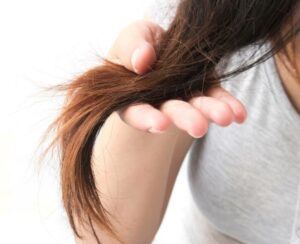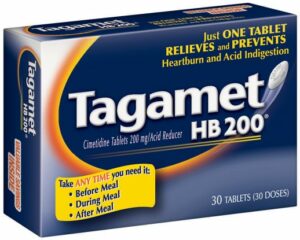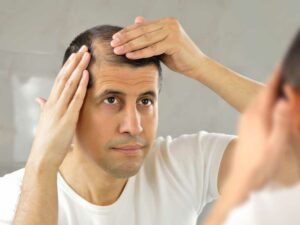The pathophysiology of both male and female alopecia (hairloss) is not yet fully understood and its therapy is unsatisfactory. Factors ranging from low scalp blood flow, deficiency of nutrients and hair-related vitamins, neurogenic effects, microbially-driven inflammatory changes, etc., have been considered. There are several alopecias known, but the prevalent type, both in men and women, is androgenic, i.e. caused by the androgenic hormones (AH) affecting the scalp hair follicles. AH are important in the physiology of skin; they promote the growth of the beard and of the body hair throughout life. The growth of the scalp hair also depends on AH, but only in early life. It is not yet explained why AH, with increasing age, switch from promoting growth of the scalp hair to its loss, inducing conditions known as an androgenic effluvium (AE) and alopecia (AGA). In hirsutism and acne vulgaris, excess of cutaneous AH was shown to be the major factor in those complex syndromes.
The AH can affect the hair only via the androgenic receptor (AR), a cellular protein transcription factor which interacts with a specific region of DNA. Thus, both testosterone and its more potent analog, 5-alpha-dihydrotestosterone (DHT), must bind to the AR in the hair follicles in order to affect hair.
Antiandrogens (AA) are systemically administered drugs which block the AH binding to AR. Originally developed for the treatment of prostate cancer, these compounds, since they block AR systemically, have considerable side effects, including loss of libido and of male sexual functions. These drugs cannot be used in males for the AE or AGA treatment at all, not even topically, since they are well resorbed from the skin and are stable in vivo. Topical steroidal AA such as cyproterone acetate, chlormadinone acetate and spironolactone were not successful, supposedly because of poor absorption into the skin; some also have a skin irritation potential.
AA administered systemically were proposed for treatment of women suffering with AE and AGA (Ref. #1), but concerns for side effects call for clinical studies. It is generally known, at least in males, that extended AR blockade leads to AR mutation, and that the mutated receptor attains the capability to be activated by other substances such as various steroidal metabolites and even progestins and estrogens, insulin-like growth factor, epidermal growth factor and keratinocyte growth factor and neuroendocrine transmitters such as serotonin. It has also been shown that the AR blockade amplifies the AR gene. It is therefore apparent that treatment of hairloss in women by blocking AR with systemic AA is not ideal and that in men it would not be acceptable at all.
Currently available for treatment of AE and AGA are the topical Minoxidil and its analogs, such as Aminexil, and the oral finasteride (Ref. #2). Minoxidil, an antihypertensive drug, incidentally prevents hairloss, and to an extent, promotes regrowth, but only in the vertex scalp; the activity is tentatively explained, among others, by activation of the prostaglandin endoperoxide synthase-1, increase of the local blood flow, suppression of bacterial infection and/or by a modification of the AH metabolism in the dermal papilla. (Refs. 3,4,5).
Finasteride taken orally and daily suppresses conversion of testosterone into dihydrotestosterone (DHT), thus lowering AH activity in the scalp. The studies indicate about half of the men achieve slight to moderate improvement in the anterior mid scalp and in approximately one-half, the effluvium is arrested. Side effects include decreased libido and erectile function, which disappear after drug withdrawal. (Ref. #6) No studies are yet available to prove whether such a long-term systemic manipulation of hormonal balance is harmless.
Clearly, a topically active antiandrogen suppressing rather than blocking the cutaneous AR, while not irritating and not absorbable from skin into the body, would be useful in the therapy of AH dependent cutaneous afflictions.
We designed and synthesized a number of novel antiandrogens and found that some, rather than blocking, suppressed the AR in a concentration and time-dependent fashion. (Ref. #7) Some of these compounds showed extremely low or no systemic bioavailability upon oral and/or topical application. The compound with the best overall properties for topically active suppression of cutaneous androgen receptors proved to be BP-766 (Fluridil), since it is rapidly biodegradable into two components of high systemic and local tolerance devoid of antiandrogenic activity. It therefore offers a novel and sound concept in handling cosmetically androgenic effluvium and incipient alopecia, as well as other skin conditions such as hirsutism which depend on the excess of the skin male hormones, both in males and females.
Fluridil’s physicochemical properties, stability, the GMP manufacturing process of the bulk and of the final product offered in 2 ml ampoules of 2% solution in isopropanol, were established. Further, Fluridil’s environmental fate and effects, mutagenicity, acute and subacute toxicity in rodents, cutaneous absorption, skin irritation and sensitization potential in animals and humans, and the mechanism of the activity, in vitro, were assessed.
In a study in human volunteers, Fluridil, even at trace levels, was not detected in the serum, therefore, it cannot be expected to have systemic effects. This was confirmed by a clinical study conducted presently at a Medical School Dermatology department (Chairman: J. Bucek, M.D., Palacky University, Olomouc, Czech Republic). In most subjects, increase in anagens (growing hair) and decrease in telogens (dying hair) after 3 months of daily application of 2 ml 2%Fluridil was substantial; there were no changes in the hematological and hormonal profiles and there were no adverse effects.
Fluridil, as a topical cosmetic agent, has received a marketing approval in the Czech Republic and approvals in other countries are pending.





